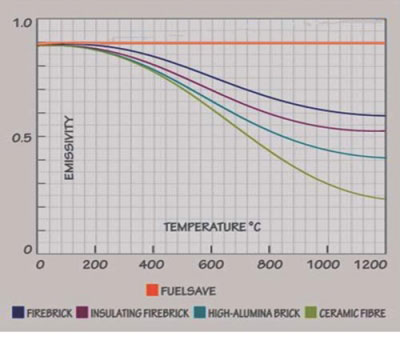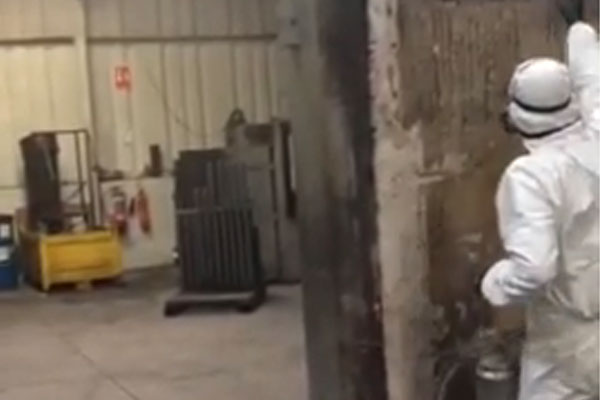Emissivity is the ratio of total heat emitted from the surface of any body of material over a specific period of time, over a given surface area at a particular temperature and wave length when compared to that of a “black” body under the same conditions. All materials have an emissivity value which is reported somewhere between 0 (lowest) and 1 (highest), a “black” body has an emissivity value of 1, but this is a hypothetical or imaginary concept, because there are no known materials which can be classified as a perfect “black” body, i.e. have the ability to radiate out 100% of the energy it absorbs. There are however substances which do exhibit extraordinarily high emissivity charateristics (factor close to 1), even at elevated temperature and these are known as “grey” bodies. FuelSave is one such material. The surface of most materials demonstrate good levels of emissivity at ambient temperature, however this often decreases substantially with an increase in temperature.
Emissivity of Refractory
The term “refractory” is an adjective meaning stubborn, unmanageable or resistant and in the context of refractory materials, it relates to heat resistance and the ability to maintain form and predictable mechanical properties at high temperatures.
Like most materials, refractories demonstrate good levels of emissivity in ambient conditions, however at elevated temperatures the emissivity factor generally decreases substantially.
Looking at data for refractory compositions typically used in furnace linings, we can see how emissivity is affected by any rise in temperature, this demonstrates the significance and effect such changes have in relation to furnace energy consumption and efficiency.
With emissivity ranging from 0.3 to 0.7 at processing temperatures for many refractory types used in reheating furnace applications, heat contribution from the furnace lining is limited.
A vessel lined with fibre insulation which has an emissivity of 0.3 will only re-radiate 30% of the energy absorbed by the hot face, while a furnace lined with a 50% alumina brick demonstrating emissivity of 0.6 would re-radiate around 60% of absorbed energy.

Fig -1 The emissivity factor of refractory materials compared to FuelSave.
Seldom is emissivity a consideration during the furnace refractory lining design process, emphasis is generally weighted towards the thermal efficiency, thermal expansion, strength characteristics and refractoriness of available materials. The emissivity factor of the chosen refractory hot face is often inconsequential and accepted as a default level (of energy contribution) which determines how the combustion system is calibrated.
The Effect of Emissivity on Thermal Processing Vessels




Science of FuelSave
The Stefan–Boltzmann law describes the power radiated from a black body in terms of its temperature. Specifically, the Stefan–Boltzmann law states that the total energy radiated per unit surface area of a black body across all wavelengths per unit time (also known as the black-body radiant emittance or radiant exitance) is directly proportional to the fourth power of the black body’s thermodynamic temperature.
Q = Єσ [Ts4-To4]
Where Є, is emissivity of the hotter surface and σ is Stephen Boltzmann’s Constant assuming a hypothetical scenario where we compare both coated and uncoated hot face surfaces of a furnace, then the following parameters are considered.
Tsurface (Temperature of hot refractory surface) = 1150°C = 1423 K
Toptimum (Temperature of load) =1100°C = 1373 K
Stephen Boltzmann’s Constant (σ) = 5.670367×10−8 Wm−2 K−4
Emissivity of Uncoated Surface (Єnc) = 0.7
Emissivity of FuelSave treated Surface (Єc) = 0.9
Heat Emitted from non-treated Surface (Qnc)
Heat Emitted from FuelSave treated Surface (Qc)
As per Stephen Boltzmann’s Law. Q= σЄ [T⁴surface – T⁴optimum] thus
Qnc= 0.7 x 5.670367 x 10−8 x [4.100-3.553] x 10-12 = 21711.96Wm2
Qc = 0.9 x 5.670367 ×10−8 x [4.100-3.553]*10-12 = 27915.37 Wm2
Energy Contribution Increase = 6203.41 Wm2
Since the emissivity of FuelSave is much higher than most refractories at elevated temperatures, the radiative capacity of a coated refractory hot face surface will be greater.
The scenario detailed above demonstrates that approximately 28% extra energy is being re-radiated from the coated refractory surface when operating in similar conditions.

